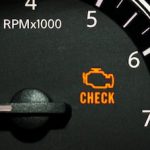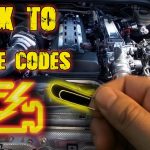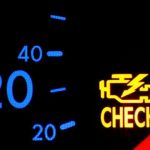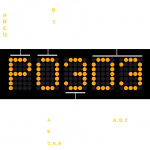
The skills you’ll gain by learning how to read OBD2 codes is similar to those you’d need if you were a mechanic. Knowing how to spot problems and which parts need repair will save you money, energy, and time.
The codes are actually letters and digits that are displayed by the control unit of your car. By learning how to read these codes, you can save yourself the hassle of taking your car to a mechanic every time it breaks down.
Diagnostic trouble codes (DTCs) are letters and digits
A DTC code is a sequence of letters and digits that describes a malfunction or problem in a car. It can range from 0 to 99, and each digit provides different information about the fault. For example, a P0219 code indicates a problem with the car’s powertrain.
The letters P and O are generic codes, while the second character identifies a specific fault index. In a nutshell, DTCs are a way for automakers to tell if their car is suffering from a problem.
DTCs are assigned letters and digits that represent a malfunction in a car’s computer. The first digit of a DTC is usually the system that is affected. The second digit is a generic code or a manufacturer-specific code. In previous versions, DTCs were grouped by manufacturer and by function. These days, however, DTCs are not separated into functional areas anymore, but instead are given a specific letter and digit that describes the specific problem.
Currently, the OBDII protocol is the most widely used in cars, and it allows you to easily diagnose a car’s problem with its code. The trouble codes are often generic codes. In order to narrow down your search, you can also include your vehicle’s model and year in the search bar. Afterward, you will be able to find a video that discusses the issue.
If you notice a DTC on your car’s dashboard, you need to know exactly what it means. It will identify the exact problem, but it will not tell you what parts or components to replace. This can lead to the wrong diagnosis. So, a good mechanic will have the most up-to-date knowledge about the code. If you don’t know how to interpret your car’s DTC, you’ll probably need to call in a mechanic for a repair.
Knowing how to interpret a DTC will help you solve any car problems. In general, trouble codes come in one of two categories: generic and manufacturer specific. Depending on your car’s model, you may have to choose between generic and manufacturer specific codes. The former is the easiest to diagnose, while Type A codes are the most difficult to repair. However, there are many resources to assist you in determining the problem.
They are found in your car’s owner’s manual
Having an idea of what your car’s OBD code is will help you diagnose the problem before you take it to the mechanic. These codes are made up of a string of letters and numbers that indicate the general cause of your Check Engine Light. They consist of single numbers from 0 to 3 and a fourth and fifth character together. They also contain pairs of numbers from 00 to 99.
The letters that precede OBD2 codes represent the systems in your car that are in need of repair. The first numeric digit is the code type; the second indicates a system within the vehicle, and the last two are the fault designation. This code is also found in the owner’s manual. A scan tool can retrieve these codes, which can then be used to diagnose problems with your car.
If you own a pre 1996 vehicle, you will need to buy an OBD I scanner to diagnose the problem. An OBD scanner will work with pre-1996) vehicles, but it will require an adapter that matches the diagnostic connector on your car. OBD II scanners work with all vehicles, although the software for each model may vary. A free online tool will provide the most accurate information for your car.
Most trouble codes will start with “p” and indicate a problem with the powertrain. You may also see “b” or “c” codes if you are having problems with the transmission or the mass air flow sensor. However, if you do not see these codes in your car’s owner’s manual, it’s best to take it to a professional mechanic.
OBD codes are vital for maintaining your car or fleet of vehicles. Understanding these codes is essential for vehicle maintenance and your fleet management strategy. When the Check Engine light comes on, you may have a wide variety of problems, many of which can be easily solved with a diagnostic scan. Even if the code doesn’t necessarily indicate the issue, the problem can still affect the performance of your vehicle.
They can be cleared by a scanner
OBD2 codes are caused by an inoperable chip in your car’s computer. To clear them, you will need a scanner. An OBDII scanner connects to the Diagnostics port between the dashboard and the driver’s seat. Once connected, turn on the scanner and wait for it to detect the code. This process may take several minutes, but the results will be worthwhile. Depending on the code you have, the process may be a bit more complicated.
An OBD scanner works by reading the fault memory in the vehicle and then clearing it. If the engine light comes on again, this may indicate a more complex problem. Sometimes, it may be a problem with an airbag or anti-lock brakes. In these cases, clearing the OBD codes yourself might not be a good idea. If the codes are complex and you are not sure what they are, it is best to visit an auto mechanic.
Using a scanner to clear the system codes is the easiest way to reset your check engine light and reset other car systems. However, you must be aware that clearing codes can make the check engine light come back, and the car may not pass state emissions tests. If you want to clear your OBD2 codes at home, the best solution is to buy a cheap OBD2 scanner. Bluetooth ELM327 OBD2 adapter is a good option for this.
A scanner works by reading the code. Once it has been cleared, the check engine light will be gone, but it will return if the underlying problem is not fixed. Remember that if you don’t solve the underlying problem, the code will pop back again. A good OBDII scanner will also give you more information about what is going on with your car. So, invest in a good OBDII scanner and save money in the long run.
OBD2 technology is standard in vehicles built after 1996. A good scanner will help you diagnose your car’s problem before it becomes expensive, and prevent you from getting overcharged by mechanics. Many code scanners can be operated from a mobile device. If you’re unsure of which one to buy, make sure to check the owner’s manual to see which codes are associated with which models.
They can be fixed by the car’s control unit
There are many common OBD2 codes, but what is the best way to fix them? This can be a very difficult task, so there are several simple methods to fix them, including the use of an OBD2 scan tool. OBD2 codes are both generic and manufacturer specific. Popular car brands include Acura, BMW, Chrysler, Dodge, Jeep, Land Rover, Mitsubishi, Nissan, and Toyota.
OBD2 codes are produced by the car’s onboard diagnostics (OBD) system. These codes are a series of five letters or numbers that identify a malfunction in a particular part of the car. If, for example, a P0442 code is generated, it indicates a leak in the evaporative emissions system. Because there are hundreds of different DTCs, the right ones can mean a multitude of different problems.
OBD2 codes can also be caused by more than one problem. Some of them can be fixed by the car’s control unit, such as a faulty brake system or low oil. Other faults can be solved by a professional mechanic. Once the car’s control unit has identified the problem, it can fix it and resolve it. It is crucial to provide the complete information to your mechanic before they begin their work.
Another common error code is P0505. This code indicates a problem with the Idle Air Control System (IAC). IAC is the component of the car’s engine that controls the idle speed. IAC circuits are sensitive to irregularities and are monitored by the car’s control unit. When the IAC circuits are damaged, the car’s Powertrain Control Module can fix it.
If you notice the OBD2 P0138, your vehicle’s second oxygen sensor isn’t working. The PCM uses this sensor to determine the position of the crankshaft. The failure of this sensor may cause an engine misfire or an inadequate amount of EGR. If this is the case, your car’s control unit needs to replace this sensor. If you are unsure of the cause, the best way to fix the problem is to contact a certified mechanic or a certified professional.






